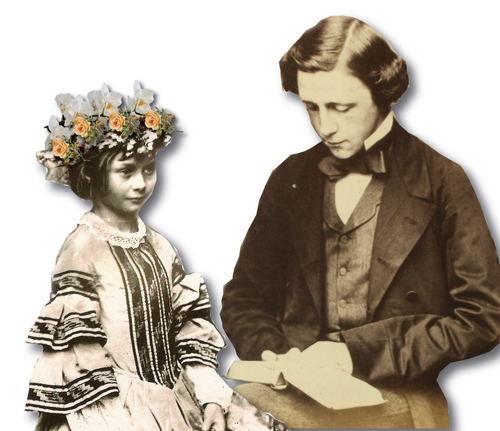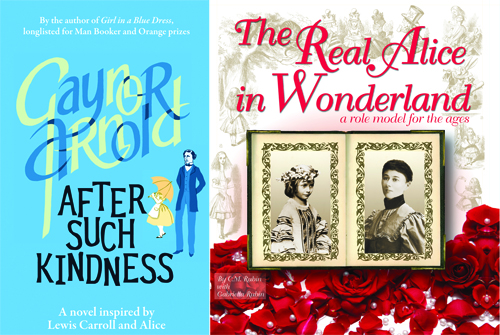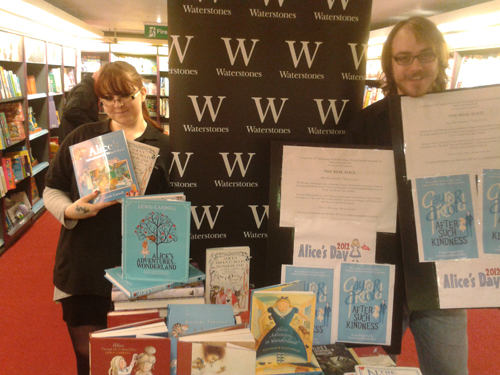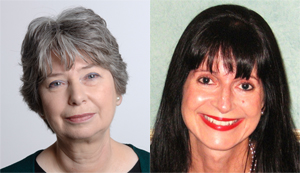
Let’s talk facts.
What was the relationship between Lewis Carroll and Alice Liddell?
That is one of the first questions people asked my co-author and me during the process of publication and marketing of our factual pictorial biography, The Real Alice In Wonderland, based on our distant relative, Alice Liddell. Critics of Lewis Carroll have claimed there was a darker side to the man who preferred the company of little girls to adults. They have accused him of perverse desires.
The facts: During his lifetime Lewis Carroll supported numerous charities with a focus on helping poor children and young women. He believed passionately in the importance of educating girls beyond domestic duties. The idea of abusing women or children disgusted him.
To write about Victorian times, one needs to understand the rules relating to women and children in Victorian society. It was not unusual for men like Lewis Carroll to have close platonic relationships with young girls like Alice. It was not uncommon for young girls like Alice to be photographed scantily clad. Carroll (a talented amateur photographer) did both these things, but first he asked permission of Alice’s parents and (perhaps even more important to Carroll) of Alice. It was also not unusual for close platonic relationships to end at the age Victorian parents started looking for suitable husbands for their daughter. Alice’s parents did not consider Carroll a prospective husband and so their friendship ended.
Throughout her life, Alice Liddell refers to Lewis Carroll as “the kindest friend a child could have.” Had it been allowed to continue, could their friendship have gone on to become anything else? It was without a doubt a very special friendship. It made Alice Liddell possibly the greatest inspiration of all time as a character behind a children’s book, but not before she made the brilliant, eccentric Carroll the most famous children’s author of all time. Our conclusion to the question? The relationship between Alice Liddell and Lewis Carroll will continue to fascinate and inspire writers (as it has since the book’s first publication nearly 150 years ago) to create all kinds of new fiction.
The latest fictional work inspired by this friendship is called After Such Kindness, by the talented author Gaynor Arnold (Booker Prize and Orange prize nominee for her fictional treatment of Charles Dickens’ marriage in Girl In a Blue Dress). Writer, Oxford scholar and photographer John Jameson visits the home of his friend, Daniel Baxter, and is entranced with Baxter’s youngest daughter — Daisy. Jameson charms her with his wit and childlike imagination, teasing her with riddles and inventing humorous stories as they enjoy afternoons alone by the river and in his rooms. Years later, the impact of this friendship is brought to light when Daisy, unsettled in her marriage, rediscovers her childhood diaries in an old toy chest.
I had the pleasure of chatting with Gaynor Arnold.

What inspired you to write your novel, After Such Kindness?
A chance encounter with something written about Lewis Carroll (no idea what) made me wonder what it would be like to write about the Alice/Dodgson relationship from the point of view of the child. The novel expanded away from that, but I think that was the starting point.
Why do you believe the relationship between Lewis Carroll and Alice Liddell is still so controversial today?
In our post-Freudian world, such an adult/child relationship is fraught with sinister connotations, especially in connection with the nude photography of little girls. It is hard for us to see this as innocent on his part; at worst it smacks of grooming for sexual abuse, and at best it seems to reveal an unhealthy obsession with the pre-pubescent body.
How do you see the actual Carroll – Liddell relationship?
From the point of view of the historical Alice, it seems to have been a pleasant interlude of childhood with an amusing uncle figure. From the point of view of Charles Dodgson, I think it was much the same: an opportunity to do what he liked best — to retreat into a childish world of puns and poems and where he could have fun with the contradictions of Victorian society. What it meant to him in his own heart, I can’t say. It doesn’t seem to have been an exclusive relationship, though, as he went on to have many more ‘child friends.’ Alice is iconic because she was one of the first (if not the first) child-friend and because the story which bears her name was written with her in mind.
In your fictional take, how do you portray the character of John Jameson?
I certainly see him as a man of contradictions: an innate conservative with a rebel streak; a prissy moralist with a taste for the theatre; and a strictly religious man who is trying to come to terms with the great challenges of Darwinian science. Above all I see him as a man who is aesthetically and intellectually advanced but emotionally immature, bedeviled by sexual feelings he cannot acknowledge.
How do you portray the character of Daisy the child and Margaret the adult?
Daisy Baxter has a very different life from Alice Liddell, and the grown-up Margaret owes nothing at all to the historical Alice. I wanted to take from the Carroll books the perplexing notions of what is real and what, a dream; how we tell who we are and who we are not; whether we are mad or sane — and apply them to Margaret’s attempts to make sense of the past.
How do you see the personal relationship between John Jameson and Daisy (from both perspectives)?
I see it as something that was important — even seminal — for both of them. I see it as a relationship of love, even if it is of a very peculiar kind. Daisy finds solace in John when her family life falls apart and she loses the person she loves most. He finds a delight in her character and her physical presence, which takes him almost to ecstasy.

What similarities do you see between the Jameson/Daisy relationship and the Dodgson/Liddell relationship?
Only the setting in the Oxford of the 1860’s and the fact that there was a similar befriending in both cases. And that a child’s story came out of it — a story whose contents I use to color my own novel.
What was your inspiration for the character of Daniel Baxter? Is Daniel modeled on Henry Liddell in any respect?
No. Daisy’s family is not the Liddell family in any respect, except that Daisy has two older sisters. I had some aspects of Charles Kingsley in mind when I wrote the character of Baxter, although again he is not based on the historical Kingsley.
How do you portray the relationship between Daisy and her parents, Daniel and Evelina Baxter?
This is an area which is completely fictional, but grows out of the manners and morality that Carroll satirizes so well in “Alice” — the fact that children were ‘seen and not heard’ and that no one attempted to explain things to them, even when those things had a devastating effect on their lives. But I suggest another current running along under the apparently happy family life. Religious doubts and sexual frustration stalk the Baxter household and Daisy is the unwitting cause and battleground for her parents’ quarrels over John Jameson.
Describe how you portray the relationship between Daniel and Evelina Baxter?
I thought it would be interesting to go against the grain of what we think about prudish Victorian sexuality, especially amongst middle-class churchgoers. I based some of the relationship of Daniel and Evelina on the very frank and erotic letters the young Charles Kingsley wrote to his wife-to-be.
Finally, do you think many Carroll historians or Alice in Wonderland fans will be disturbed by your story albeit fictional?
I daresay there will be some who don’t understand — or don’t like — the use of historical figures in fiction, and will be annoyed by any departure from the known facts or any imagined slur on Dodgson’s name. But I feel my portrayal of John Jameson is essentially sympathetic, and that of Daisy even more so. One of the reasons that I have given them different names and altered their backgrounds is because I am not making any attempt to pretend these people are Lewis Carroll or Alice Liddell. Indeed, anyone who knows anything about Carroll or the Liddells will realize that. Instead, I’m just speculating about a similar child/adult situation and how it looks from our standpoint today.
Gaynor Arnold (After Such Kindness, Tindal Street Press, July 5, 2012), and C. M. and Gabriella Rubin (The Real Alice in Wonderland) will be discussing and signing copies of their respective books on Alice’s Day, July 7, 2012 at Waterstones bookstore in Oxford.
For more information: http://www.storymuseum.org.uk/the-story-museum/alice/Alice2012/waterstones-2

Photos courtesy of Waterstones, Gaynor Arnold, and Henmead Enterprises, Inc.
For more Alice articles: click here
C. M. Rubin is the author of two widely read online series for which she received a 2011 Upton Sinclair award, “The Global Search for Education” and “How Will We Read?” She is also the author of three bestselling books, including The Real Alice in Wonderland.

Recent Comments